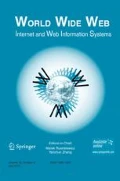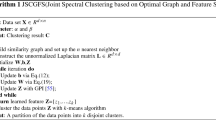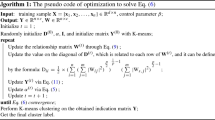Abstract
Spectral clustering is a popular graph-based clustering method which is widely applied to pattern recognition and image segmentation. Traditional spectral clustering usually involves two separate processes: graph learning and graph-based clustering, making such a two-step strategy easily output sub-optimal performance and moreover, noisy data and imbalanced clusters could make existing clustering methods hard to meet practical necessity. To this end, one-step spectral clustering coupled with a balanced constraint is proposed to jointly optimize the robust low-dimensional representation, the spectral rotation and the cluster indicator in a unified learning framework. Specifically, dimensionality reduction is conducted by combining subspace learning and feature selection to obtain a robust low-dimensional representation. Besides, a spectral rotation mechanism is used to produce one-step clustering for reducing clustering biases, and a balanced constraint is utilized to regularize the clustering result to generate clusters with similar sizes. Moreover, an iterative optimization method is put forward to fast solve the proposed objective function. Experimental results on ten benchmark datasets compared to state-of-the-art spectral clustering methods showed that our proposed clustering method could output the balanced clusters and the competitive clustering performance simultaneously.



Similar content being viewed by others
References
Banerjee, A., Ghosh, J.: Frequency-sensitive competitive learning for scalable balanced clustering on high-dimensional hyperspheres. IEEE Trans. Neural Netw. 15(3), 702–719 (2004)
Bertsekas, D.P.: Constrained optimization and Lagrange multiplier methods. Academic Press, New York (1982)
Boyd, S., Parikh, N., Chu, E., Peleato, B., Eckstein, J.: Distributed optimization and statistical learning via the alternating direction method of multipliers. Found. Trends Mach. 3(1), 1–122 (2011)
Campello, R. J. G. B., Moulavi, D., Sander, J.: Density-Based Clustering Based on Hierarchical Density Estimates. In: PAKDD, pp. 160–172 (2013)
Chen, X., Chen, R., Wu, Q., Fang, Y., Nie, F., Huang, J.Z.: LABIN:, balanced min cut for large-scale data. IEEE Trans. Neural Netw. Learn. Syst. 31(3), 725–736 (2020)
Chen, X., Hong, W., Nie, F., Huang, J. Z., Shen, L.: Enhanced balanced min cut. Int. J. Comput. Vis. 128(7), 1982–1995 (2020)
Chen, X., Huang, J. Z., Nie, F., Chen, R., Wu, Q.: A Self-Balanced Min-Cut Algorithm for Image Clustering. In: ICCV, pp. 2080–2088 (2017)
Chen, X., Nie, F., Huang, J. Z., Yang, M.: Scalable Normalized Cut with Improved Spectral Rotation. In: IJCAI, pp. 1518–1524 (2017)
Daubechies, I., Devore, R., Fornasier, M., Güntürk, C. S.: Iteratively reweighted least squares minimization for sparse recovery. Commun. Pure Appl. Math. 63(1), 1–38 (2010)
Gan, J., Peng, Z., Zhu, X., Hu, R., Ma, J., Wu, G.: Brain functional connectivity analysis based on multi-graph fusion. Medical Image Analysis. https://doi.org/10.1016/j.media.2021.102057 (2021)
Hagen, L. W., Kahng, A. B.: New spectral methods for ratio cut partitioning and clustering. IEEE Trans. Comput.-Aided Des. Integr. Circ. Syst. 11 (9), 1074–1085 (1992)
Han, J., Liu, H., Nie, F.: A local and global discriminative framework and optimization for balanced clustering. IEEE Trans. Neural Netw. Learn. Syst. 30(10), 3059–3071 (2019)
Hartigan, J. A., Wong, M. A.: A k-means clustering algorithm. J. R. Stat. Soc. 28(1), 100–108 (1979)
Hu, R., Peng, Z., Zhu, X., Gan, J., Zhu, Y., Ma, J., Wu, G.: Multi-band brain network analysis for functional neuroimaging biomarker identification. IEEE Transactions on Medical Imaging. https://doi.org/10.1109/TMI.2021.3099641 (2021)
Huang, J., Nie, F., Huang, H.: Spectral Rotation versus K-Means in Spectral Clustering. In: AAAI, pp. 431–437 (2013)
Ieva, C., Gotlieb, A., Kaci, S., Lazaar, N.: Discovering program topoi via hierarchical agglomerative clustering. IEEE Trans. Reliab. 67(3), 758–770 (2018)
Kang, S. H., Sandberg, B., Yip, A. M.: A regularized k-means and multiphase scale segmentation. Inverse Probl. Imaging 5(2), 407–429 (2011)
Li, L., Jiang, X., Zhong, S., Hu, L.: Energy Balancing Clustering Algorithm for Wireless Sensor Network. In: International Conference on Networks Security, Wireless Communications and Trusted Computing, vol. 1, pp. 61–64 (2009)
Li, Z., Nie, F., Chang, X., Ma, Z., Yang, Y.: Balanced Clustering via Exclusive Lasso: A Pragmatic Approach. In: AAAI, pp. 3596–3603 (2018)
Liang, J., Zhao, X., Li, D., Cao, F., Dang, C.: Determining the number of clusters using information entropy for mixed data. Pattern Recognit. 45 (6), 2251–2265 (2012)
Liu, H., Han, J., Nie, F., Li, X.: Balanced Clustering with Least Square Regression. In: AAAI, pp. 2231–2237 (2017)
Malinen, M. I., Frȧnti, P.: Balanced K-Means for Clustering. In: Structural, Syntactic, and Statistical Pattern Recognition-Joint IAPR, Lecture Notes in Computer Science, vol. 8621, pp. 32–41 (2014)
Nallusamy, R., Duraiswamy, K., Dhanalaksmi, R., Parthiban, P.: Optimization of non-linear multiple traveling salesman problem using k-means clustering, shrink wrap algorithm and meta-heuristics. Int. J. Nonlinear Sci. 9(2), 171–177 (2010)
Ng, A. Y., Jordan, M. I., Weiss, Y.: On Spectral Clustering: Analysis and an Algorithm. In: NIPS, pp. 849–856 (2001)
Nie, F., Li, J., Li, X.: Self-Weighted Multiview Clustering with Multiple Graphs. In: IJCAI, pp. 2564–2570 (2017)
Nie, F., Wang, X., Jordan, M. I., Huang, H.: The Constrained Laplacian Rank Algorithm for Graph-Based Clustering. In: AAAI, pp. 1969–1976 (2016)
Nie, F., Zhang, R., Li, X.: A generalized power iteration method for solving quadratic problem on the stiefel manifold. Sci. China (Inf. Sci.) 60(11), 146–155 (2017)
Pang, Y., Xie, J., Nie, F., Li, X.: Spectral clustering by joint spectral embedding and spectral rotation. IEEE Trans. Cybern. 50(1), 247–258 (2020)
Shen, H. T., Zhu, Y., Zheng, W., Zhu, X.: Half-quadratic minimization for unsupervised feature selection on incomplete data. IEEE Trans. Neural Netw. Learn Syst. https://doi.org/10.1109/TNNLS.2020.3009632 (2020)
Shi, D., Zhu, L., Li, Y., Li, J., Nie, X.: Robust structured graph clustering. IEEE Trans. Neural Netw. Learn. Syst. 31(11), 4424–4436 (2020)
Shi, J., Malik, J.: Normalized cuts and image segmentation. IEEE Trans. Pattern Anal. Mach. Intell. 22(8), 888–905 (2000)
Shi, Z., Ghosh, J.: Model-Based Clustering with Soft Balancing. In: ICDM (2003)
Thanigaivelu, K., Murugan, K.: Grid-based clustering with predefined path mobility for mobile sink data collection to extend network lifetime in wireless sensor networks. IETE Tech. Rev. 29(2), 133–147 (2012)
Usha, S. G. A., Vasuki, S.: Improved segmentation and change detection of multi-spectral satellite imagery using graph cut based clustering and multiclass SVM. Multim. Tools Appl. 77(12), 15353–15383 (2018)
Wagstaff, K., Cardie, C., Rogers, S., Schrȯdl, S.: Constrained K-Means Clustering with Background Knowledge. In: ICML, pp. 577–584 (2001)
Wen, G., Zhu, Y., Zheng, W.: Spectral representation learning for one-step spectral rotation clustering. Neurocomputing 406, 361–370 (2020)
Yang, S., Hou, C., Nie, F., Wu, Y.: Unsupervised maximum margin feature selection via L, 2, 1-norm minimization. Neural Comput. Appl. 21 (7), 1791–1799 (2012)
Zhu, X., Song, B., Shi, F., Chen, Y., Hu, R., Gan, J., Zhang, W., Li, M., Wang, L., Gao, Y., et al.: Joint prediction and time estimation of covid-19 developing severe symptoms using chest ct scan. Med. Image Anal., 67. https://doi.org/10.1016/j.media.2020.101824 (2021)
Zhu, X., Zhang, S., Hu, R., Zhu, Y., Song, J.: Local and global structure preservation for robust unsupervised spectral feature selection. IEEE Trans. Knowl. Data Eng. 30(3), 517–529 (2018)
Zhu, X., Zhang, S., Li, Y., Zhang, J., Yang, L., Fang, Y.: Low-rank sparse subspace for spectral clustering. IEEE Trans. Knowl. Data Eng. 31 (8), 1532–1543 (2019)
Zhu, X., Zhang, S., Zhu, Y., Zhu, P., Gao, Y.: Unsupervised spectral feature selection with dynamic hyper-graph learning. IEEE Trans. Knowl. Data Eng. https://doi.org/10.1109/TKDE.2020.3017250 (2020)
Zhu, Y., Ma, J., Yuan, C., Zhu, X.: Interpretable learning based dynamic graph convolutional networks for alzheimer’s disease analysis. Inf. Fusion 77, 53–61 (2022)
Acknowledgements
This work was partially supported by the Key Program of the National Natural Science Foundation of China (Grants No: 61836016 and 61672177); the Natural Science Foundation of China (Grants No: 61876046); the Guangxi Collaborative Innovation Center of Multi-Source Information Integration and Intelligent Processing and the Research Fund of Guangxi Key Lab of Multisource Information Mining & Security (18-A-01-01); the Guangxi “Bagui Scholar” Teams for Innovation and Research Project; Natural Science Project of Guangxi Universities (2021KY0061).
Author information
Authors and Affiliations
Corresponding author
Ethics declarations
Conflicts of interest/Competing interests
No conflict of interest exists. We declare that we have no financial and personal relationships with other people or organizations that can inappropriately influence our work.
Additional information
Availability of data and material
Ten benchmark datasets used in the experiment are collected from the UCI Machine Learning Repository (http://archive.ics.uci.edu/ml/) and the website of Feature Selection Data sets (http://featureselection.asu.edu/datasets.php)
Publisher’s note
Springer Nature remains neutral with regard to jurisdictional claims in published maps and institutional affiliations.
This article belongs to the Topical Collection: Special Issue on Web Intelligence =Artificial Intelligence in the Connected World
Guest Editors: Yuefeng Li, Amit Sheth, Athena Vakali, and Xiaohui Tao
Rights and permissions
About this article
Cite this article
Wen, G., Zhu, Y., Chen, L. et al. One-step spectral rotation clustering with balanced constrains. World Wide Web 25, 259–280 (2022). https://doi.org/10.1007/s11280-021-00958-4
Received:
Revised:
Accepted:
Published:
Issue Date:
DOI: https://doi.org/10.1007/s11280-021-00958-4




